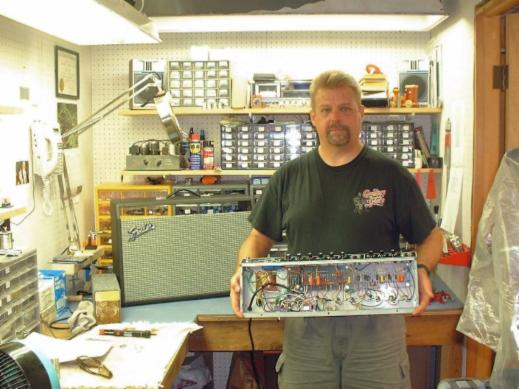Visiting Mikey
In July, I traveled to Baltimore, Maryland (USA) with my DRRI to meet with Mikey. I arrived in the early afternoon and took copious notes to share the experience with you. Here’s how we spent the day, including a lot more information that I learned about rebuilding this DRRI amplifier.

Once I arrived, I carried my two favorite Hamer guitars and my DRRI amp in from the car and met Mikey for the first time, and his two cats. One cat is unabashedly friendly and the other one is quite reserved and timid. After getting the animal familiarities out of the way, Mikey and I took some time to get to know each other. I asked him about his business name, MikeyMann Amplification. He shared with me that once when visiting his oldest niece, she spontaneously said, " Hey, Uncle Mikey Man!" Then, whenever she saw him, she’d call him “Uncle Mikey Man”. This term of endearment has been used by all of his nieces over the years, which is how the name MikeyMann Amplification came to be.
We then talked about our love of tube amplifiers, guitars and the musicians that have influenced us. We shared war stories of bands we had played in over the years and most importantly, discussed the amps we’ve played in the past and the amps we own today. We also discussed the state-of-the-art in modern tube amp construction and spoke of the knowledge we’ve both gained by participating in the AGA newsgroup (alt.guitar.amps).
We also discussed a host of Internet sites, tube amp books and interactions with other musicians that have helped us out. I’ve learned a lot from the Gear Page forum.
Mikey highly recommends the ToneQuest Report for detailed reviews on amps, guitars and other musicians’ toys. He says:
“It's my favorite publication, even above Guitar Player. I look forward to receiving it each month, and I devour it for its information and knowledge. I save all of my issues so that I can refer back to specific articles and information. It's also cool to read what some of the great players are using, how they have their rigs set up, etc.” I like it too.
Mikey is a joy to talk to about these topics and we spent the first couple of hours in animated conversation. Mikey took the time to talk about his vision of rebuilding reissue amps with modern construction techniques using the best of modern components. His vision is to build amps for working musicians, pros, semi-pros and serious players who want the best possible tone and top-notch reliability. He makes a compelling case for using the cabinet, chassis and some of the components of the Fender reissue series instead of buying an old Blackface or Silverface amp and only upgrading some of the components, leaving 30 – 40 year old components in place that could fail at an inopportune time.
I thought you might enjoy reading Mikey’s vision as stated in an email he wrote me:
“Lots of players want/need great tone, but can't afford the thousands it usually takes to get a handmade or boutique amp, or even certain vintage amps whose costs have skyrocketed over the last few years. My goal is to offer great tone and make it more affordable to a greater number of players. Also, many gigging musicians and pros don't want to take their vintage gear on the road for fear that it will get stolen or destroyed. By rebuilding reissue amps like the Deluxe Reverb, they get the great vintage looks and tone but don't have to worry about a priceless vintage amp getting stolen or damaged. If so, they can simply get another one!”
“My personal feeling is that if someone does buy a 40 year old vintage amp, chances are it will have new electrolytics, probably some new coupling and tone caps, new resistors (at least plate resistors), maybe a new output transformer, new tubes, maybe a new speaker, maybe even a new power transformer. So, does the player "really" have a vintage amp? I say that they have a vintage chassis, vintage cab but not a "vintage amp". Once you start replacing a bunch of stuff on a 40-year-old amp, it ceases to be a "vintage amp", in my humble opinion. You still have a vintage chassis and cab, but with a bunch of new parts. So, you're paying all that money for a "vintage amp", but you're not totally getting a vintage amp, just a vintage chassis with a bunch of new parts. Where's the logic in that?”
After our very pleasant and wide-ranging conversation, it was time to delve into the details of the amp rebuild.